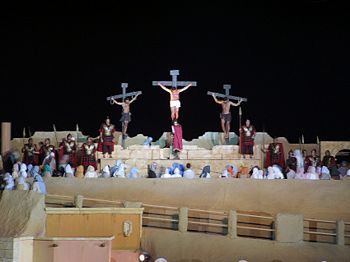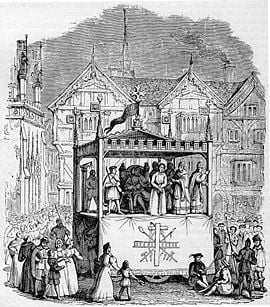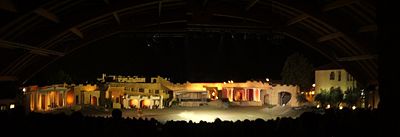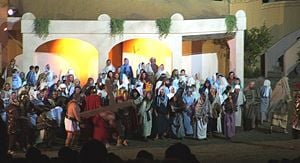Passion play
A Passion play is a dramatic presentation depicting the Passion of Christ: the trial, suffering and death of Jesus Christ. It is a traditional part of Lent in several Christian denominations, particularly in Catholic tradition.
Historically, Passion plays grew out of the liturgy of the Catholic Church and developed into elaborate performances covering the entire history of God's providence of human redemption, in which the Passion is thought to play the central role. They later evolved into more focused dramatic presentations dealing with the the final events in Jesus' life, death, and resurrection.
The plays, which became increasingly elaborate and sometimes featured hundreds of actors, were highly popular in the fourteenth and fifteenth centuries. They then became more secularized and were even banned in some areas by Catholic authorities, becoming even more scarce after the Protestant Reformation. Several versions of the plays survived, however, and they experienced a revival in popularity beginning in the late nineteenth century.
Passion plays also figure in the history of antisemitism, as they blamed the Jews for the death of Jesus, resulting in a rise in anti-Jewish violence after their performances. The Catholic Church of the twentieth centuries issued guidelines cautioning Christians to avoid negative stereotypes of Jews in depicting the events surrounding Jesus life and death.
Currently, Passion plays have begun to attract large crowds again. Contemporary productions have been created throughout the world, some of them featuring hundreds of actors, huge stages, and crowds of tens of thousands. The film Passion of the Christ, produced and directed by Mel Gibson, is essentially a Hollywood version of a Passion play.
Origin and history
The Passion play originated in the ritual of the Catholic Church, which prescribes that the Gospel on Good Friday should be sung in parts divided among various persons. First performed in Latin, then in vernacular languages, the contents and forms were adapted and by the fifteenth century, the popular religious plays had developed. By this time, the plays were more dramatic than liturgical in form, involving elaborate props and well-rehearsed action. They also began to be written in rhyme, principally in German.
The Vienna Passion embraced the entire providential history of human Redemption, beginning with the revolt and fall of Lucifer and ending with Jesus and his Twelve Apostles sitting at the Last Supper. The oldest Frankfort Passion play, that of Canon Baldemar von Peterwell (1350-1380), required two days to perform. Of this play only the Ordo sive Registrum has been preserved, containing stage directions and the first words of the dialogues. The Celtic versions of Cornwall and Brittany also exemplify this genre. In England, record of 1422 shows that playsof this type took place at the feast of Corpus Christi. In 1475 they included The trial and flagellation of Christ and The Crucifixion. The plays were then expanded into a three day cycle.
The Passion play reached its highest development in the period 1400-1515, including such examples as the later Frankfort version (1467), the Alsfelder, and the Friedberger (1514) adaptations. Connected with this group are the Eger, the Donaueschingen, Augsburg, Freising and Lucerne Passion plays. These dramas typically began with the creation of man and concluded with the coming of the Holy Ghost at Pentecost.
The Tirolese Passion play, taking its name from the Austrian region of Tirol, originated during the this period. At Bozen (Bolano, northern Italy) these plays were presented with great splendor and lasted seven days. Here, too, the innovation of placing the female roles in the hands of women was introduced, which did not become general practice until during the seventeenth century. The Tirol plays soon formed a separate group, representing only scenes from the Passion and Resurrection, from which the term "Passion play" is derived.
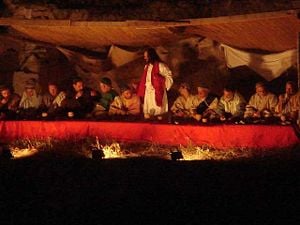
The magnificent productions of the Passion plays during the fifteenth century are connected with the growth and increasing self-confidence of the cities, which found its expression in gorgeous public festivals. Citizens and civil authorities considered it a point of honor to render the production as rich and diversified as possible. People of the most varied classes took part in the production, and frequently the number of actors was as high as 200 and even greater. If was undoubtedly no small task to drill the performers, particularly since the stage arrangements were still very primitive.
The stage was a wooden structure, almost as broad as it was long, elevated but slightly above the ground and open on all sides. Often performed in a public square, house formed the background; a balcony attached to the house represented Heaven. Under the balcony three crosses were erected. Along the sides of the stage stood the "houses" required for the production, indicated by fenced-in spaces or by four posts upon which a roof rested. The entrance into Hell was pictured by the mouth of a monster, through which the Devil and the souls captured or released during the plays passed back and forth. The actors entered in solemn procession, led by musicians or by a (herald). They remained on the stage all through the performance leaving their assigned places only to step forward torecite their lines. As each actor finished speaking, he returned to his place. The audience stood around the stage or looked on from the windows of neighboring houses. Occasionally platforms, called "bridges," were erected around the stage in the form of an amphitheatee.
Scenery, action and costumes
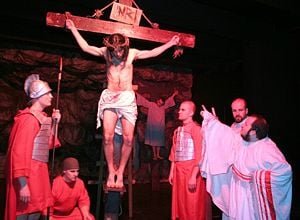
The scenery was as simple as the stage. There were no side scenes, and consequently no stage perspective. A cask standing on end might represent the mountain on which Christ was tempted by the Devil; thunder is imitated by the report of a gun.
In order to signify that the Devil had entered into him, Judas holds a bird of black plumage before his mouth and makes it flutter. The suicide of Judas is an execution, in which Beelzebub performs the hangman's duty. He precedes the culprit up the ladder and draws Judas after him by a rope. Judas has a black bird and the intestines of an animal concealed in the front of his clothing. When Satan tears open the garment, the bird flies away, and the intestines fall out, whereupon Judas and his executioner slide down into Hell on a rope.
A painted picture representing the soul is hung from the mouth of each of the two thieves on the cross; an angel takes the soul of the penitent, the Devil that of the impenitent thief. All costumes are contemporary, historical accuracy being ignored.
Secularization
The Passion plays of the fifteenth century, with their peculiar blending of religious, artistic, and increasingly secular elements, gave a true picture of German city life of those times. Serious thought and lively humor were highly developed in these plays. In the sixteenth century, however, the plays direction was left to the lower classes and began to lose their dignified character. The influence of the Carnival plays was felt more and more. For example, the character of Master Grobianus, with his coarse and obscene jests, was introduced into some plays. In time the ecclesiastical authorities forbade the production of these "secularized" plays. For example, in 1471, the bishop of Havelberg commanded his clergy to suppress the plays their parish districts because of the disgraceful and irrelevant farces interspersed through the productions.
With the advent of the sixteenth century and the Protestant Reformation, European uneasiness with liturgical drama in general increased. The Synod of Strasburg of 1549 opposed the religious plays, and the Parliament of Paris of 1548 forbade the production of The Mysteries of the Passion of our Redeemer and other Spiritual Mysteries. A consequence o this policy was that secularized plays were separated from religious ones, and Carnival plays gained in popularity. The Passion plays came to be presented more rarely, particularly as the Reformation was inimical to them.
School dramas now came into vogue in both Catholic and Protestant academic institutions. In the seventeenth century, when the splendidly equipped Jesuit drama arose, the Passion plays, still largely secularized, were relegated to out-of-the-way villages and to the monasteries, particularly in Bavaria and Austria. Toward the end of the eighteenth century, during the Age of Enlightenment, efforts were made in Catholic Germany, particularly in Bavaria and the Tyrol, to destroy even the remnants of the tradition of medieval plays.
Public interest in the Passion play developed again in the last decades of the nineteenth century. Since then, Brixlegg and Vorderthiersee in the Tyrol, Horice na Sumave, near Cesky Krumlov in the Czech Republic, and above all, the Oberammergau in Upper Bavaria attract thousands to their plays.
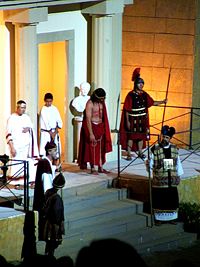
Jewish objections
Passion plays often produced the unfortunate side-effect of of hatred and sometimes violence against Jews, who are typically presented as the villains in the dramatic scenes of Jesus' trial and condemnation, just before his crucifixion. Violence directed against Jews tended to escalate during Holy Week, and Jews in cities and towns throughout Europe learned to stay off the streets when Passion plays were being performed.
In 1965 the Second Vatican Council promulgated Nostra Aetate, officially repudiating antisemitism and specifically rejecting the idea that today's Jews can be held in any way responsible for the death of Jesus. Most Protestant churches have made similar declarations. The Catholic Church also urges caution in dramatic presentations of the Passion in light of their potential to cause anti-Jewish sentiment. The US Council of Catholic Bishops published the pamphlet "Criteria for the Evaluation of Dramatizations of the Passion," emphasizing that Passion plays must avoid caricatures of Jews clamoring for the death of Jesus and other negative stereotypes.
Modern performances
The chief survivor of the Passion plays of former times is the Oberammergau Passion Play, first performed in the Bavarian village of Oberammergau, which continues to perform it every decade despite objections from Jewish groups that feel the performances promote anti-Semitism. More recently, Passion plays have experience a new popularity, especially among Protestants, as well as Catholics, throughout the world.
Europe
The tradition of passion plays in Poland became popular again in from the early early century, although it suffered during the Communist period after WWII. Today the best known plays take place in Kałków, Kalwaria Pacławska, the Pallotines' Seminary in Ołtarzew, and the most prominent in Sanctuary of Kalwaria Zebrzydowska. This passion play is one of the oldest and biggest in Europe, gathering around 100 thousand pilgrims each year on Good Friday.
In the Netherlands, De Passiespelen is a re-enactment of the Passion taking place every five years. It is performed in the open air in Openluchttheater De Doolhof] in Tegelen. Originating in 1931 it has become an internationally acclaimed event drawing visitors from all over the world.
In Catalonia, Spain, it is common for villages to present varous passion plays every Easter, like the ones in Esparreguera, Olesa de Montserrat or Cervera, first documented in 1538. Olesa's 1996 production featured 726 persons on stage at the same time. Another large-scale Passion play is Italy's La passione di Cristo in Sordevolo.
In the United Kingdom, the town of Leominster in Herefordshire holds an outdoor Passion play on Good Friday every four years, performed by volunteers from churches of all denominations in the town. The 2008 performance included original music written by local composer Liam Dunachie. BBC Three broadcast a modern musical version called Manchester Passion in 2006.
The Americas
In Brazil, the Passion of the Christ is performed every year during Easter in huge theatre-city in the arid backlands of Pernambuco. It is considered to be the largest open-air theatre in the world. More than 500 actors appear on the nine separate stages within the stone walls of the city.
The Canadian Badlands Passion Play is performed annually in Drumheller, Alberta. Other performances take place in the amphitheatre in the hills of the Drumheller valley, Queensway Cathedral in Toronto, La Riviere Valley Manitoba, and Kingston, Ontario atKingston Gospel Temple
In the US, the longest running passion play has been performed in Union City, New Jersey since 1915, and at the Park Theater since 1931. In Zion, Illinois, the Zion Passion Play has been performed at Christ Community Church since 1935.one of the most widely viewed Passion plays is "The Promise," performed near Glen Rose, Texas. Between Glen Rose, and its sister production in Branson, Missouri, over 1 million people have seen The Promise. Florida's passion play is held annually in Wauchula at the Cattlemans Arena, beginning Good Friday and for the next several following weekends. It has a cast of over 200 people and 150 animals. In Eureka Springs, Arkansas, "The Great Passion Play" is regularly performed. Since its first performance in 1968, the play has been seen by over 7.5 million people making it the largest attended outdoor drama in the US. The North Heights Passion Play was a popular indoor musical stage production sponsored by North Heights Lutheran Church of Arden Hills, Minnesota, a suburb of the Twin Cities. The Black Hills Passion Play is performed every summer in Spearfish, South Dakota.
Many Protestant churches now put on productions of Passion plays which draw many visitors. For example, The Glory Of Easter at the Crystal Cathedral in Garden Grove, California is a popular family tradition to Southern Californians. It boasts a cast of hundreds, live animals, and flying angels, among other unique aspects.
The 2004 feature film The Passion of the Christ (produced and directed by Mel Gibson) had a plot similar to that of Passion plays.
Asia and Oceania
In Australia, there are several major productions of The Passion staged annually in the lead up to Easter.
The Philippines has Passion plays called Senakulo, named after the Upper room, which companies perform during Holy Week. Actual crucifixions are reenacted outside of some Passion plays especially the City of San Fernando, Pampanga.
The Church of Immaculate Conception in Bangkok holds an annual Passion Play on Good Friday.
See also
- Jesus Christ
- Arrest of Jesus
- Trial of Jesus Christ
- Crucifixion of Jesus Christ
- Resurrection of Jesus Christ
- Dramatic portrayals of Jesus
- The Passion of the Christ
- Concern over Antisemitism in Passion Plays
- Gospel
- Mummers Play
- Liturgical drama
- ta'ziya—Shiite Muslim passion play commemorating the martyrdom of Husayn bin Ali
- Sacri Monti
Notes
ReferencesISBN links support NWE through referral fees
External links
- The Zion Passion Play in Zion, Illinois
- Resurrection Song An original Easter musical
- The Atlanta Passion Play
- The Great Passion Play in Eureka Springs, AR
- The Canadian Badlands Passion Play in Drumheller Alberta Canada
- Manitoba's Passion Play in the Pembina Valley near La Riviere, Manitoba, Canada
- The Andrews University Passion Play
- North Heights Passion Play, an indoor musical stage production at North Heights Lutheran Church in Minnesota - photos
- The Iona Passion Play
- Moogerah Passion Play
- The Turramurra Passion
- The Olesa de Montserrat Passion
- The Esparreguera Passion
- An annual Passion Play produced in Pittsburgh, PA
- The Passion Musical at The Texas Amphitheatre in Glen Rose, TX
- The Passion of the Christ in Nova Jerusalém, Brazil
- The Passion Play: One man stage performance by Doug Barry - Filmed at the Orpheum Theatre
- The Passion Play in the Sacri Monti of Piedmont and Lombardy
- The Passion Play in the Sanctuary of Kalwaria Zebrzydowska, Poland
- The Glory Of Easter at the Crystal Cathedral in Garden Grove, CA.
- The passion play performed in Townsend,TN
Credits
New World Encyclopedia writers and editors rewrote and completed the Wikipedia article in accordance with New World Encyclopedia standards. This article abides by terms of the Creative Commons CC-by-sa 3.0 License (CC-by-sa), which may be used and disseminated with proper attribution. Credit is due under the terms of this license that can reference both the New World Encyclopedia contributors and the selfless volunteer contributors of the Wikimedia Foundation. To cite this article click here for a list of acceptable citing formats.The history of earlier contributions by wikipedians is accessible to researchers here:
The history of this article since it was imported to New World Encyclopedia:
Note: Some restrictions may apply to use of individual images which are separately licensed.
